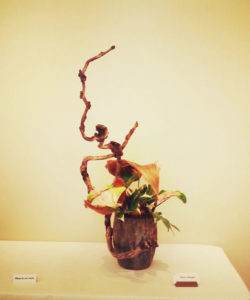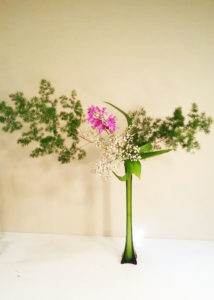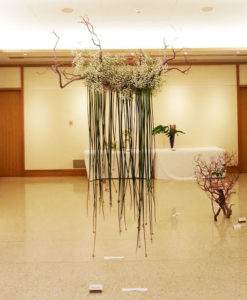 Ikebana is the known as Japanese flower arrangement. As a student of ikebana of many years, I want people to know that ikebana is not just a flower arrangement, it is an art form and a philosophy that captures a part of Japanese culture.
Ikebana is the known as Japanese flower arrangement. As a student of ikebana of many years, I want people to know that ikebana is not just a flower arrangement, it is an art form and a philosophy that captures a part of Japanese culture.
Ikebana began over 600 years ago when the Buddhist monks placed flowers by the alter. It later moved to the traditional Japanese tatami room in an alcove called the tokonoma. Arranging flowers in the living spaces were mainly enjoyed by the aristocrats, but slowly over the centuries it spread to the common people.
Today, ikebana is practiced and enjoyed by over 15 million people in Japan. In 1956, several American women who resided in Japan wanted to continue to spread the love of ikebana to others and established Ikebana International. This non-profit organization now has spread to over 50 countries. It just shows us that the love for flowers, branches, and nature has no barriers. Nature makes us happy!
There are many different schools of ikebana, each with their own style of practice. I study with the Sogetsu School. Just like any practice, you begin with the basics building your foundation skills. Through years of practice, your development enables you to create your own original arrangements.
The reason why I consider ikebana as not only an art form but as a philosophy is because it has taught me many lessons in life.
For example, the materials we use are natural materials found in nature. Once cut they have a limited life span. As Master Tetsunori Kawana taught us, “nature is perfect. What we are doing is removing something that is already perfect and must give it new life.” With respect to nature, we are trying to create something just as beautiful that speaks to people. That’s a tall request, but it’s one that we strive for.
When working with different materials, you begin to understand that each plant has unique qualities. Some can bend easily with the warmth of your palms, others are stiff and prickly. Their lifespan in water varies too. Knowing the characteristics is part of the success of the piece.
In our school, we are allowed to use other tools such as wire, pins, clips, nails, and tape to help construct our compositions. But, we are reminded that they are simply tools and must remain as that. Through our pieces, we are given the opportunity to tell stories, provoke imagination or bring out emotions.
As more of our lifestyles become dependent on the digital world, ikebana is a great way to disconnect. We don’t need to rely on technology here. In fact, we don’t want to. Ikebana allows us to connect with nature, as a means of personal expression. The piece here with the tall green vase is mine.
Last weekend we had our 2016 Sogetsu Seattle Exhibition at the Seattle Asian Art Museum. I just wanted to share my teacher’s piece. The 2-D image doesn’t do justice, because it’s hard to show scale and depth.
What can you see in this piece? Does it make you stop to think? Can you connect with this? What do you feel?
As time progresses, my love for ikebana also grows. It makes my life fuller by connecting to nature, people, and our creativity.
If you’d like to learn ikebana in the Greater Seattle area, please come join us. This links to my teacher Megumi Schacher, who I think is just wonderful!




